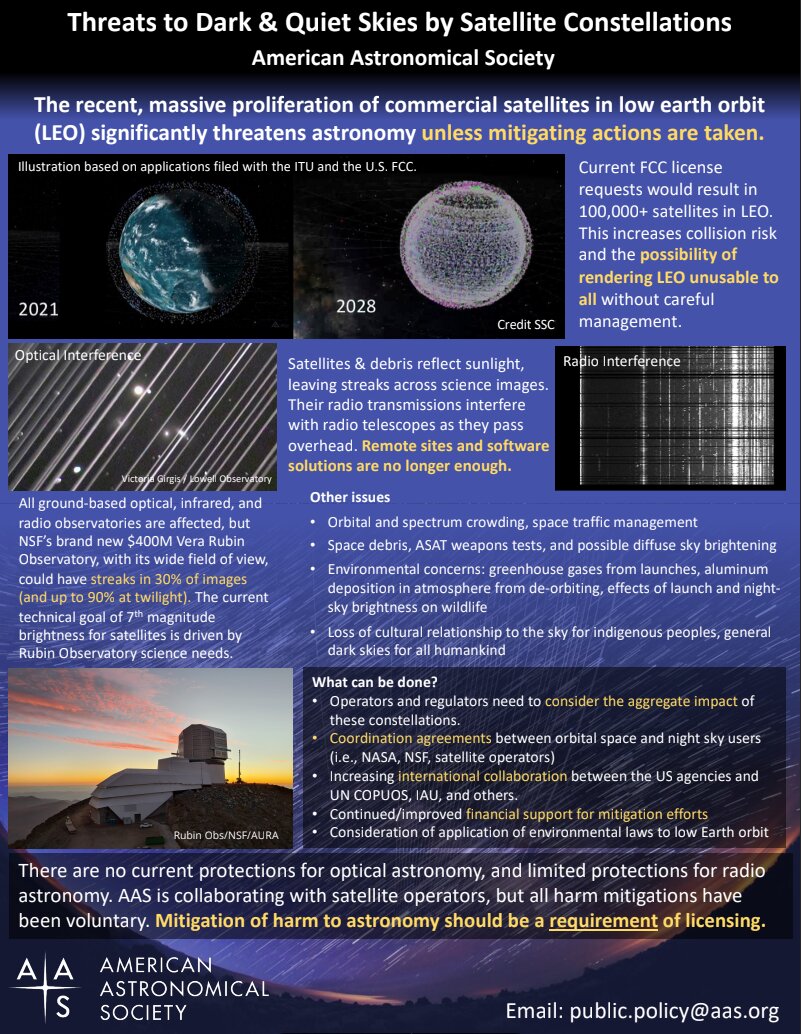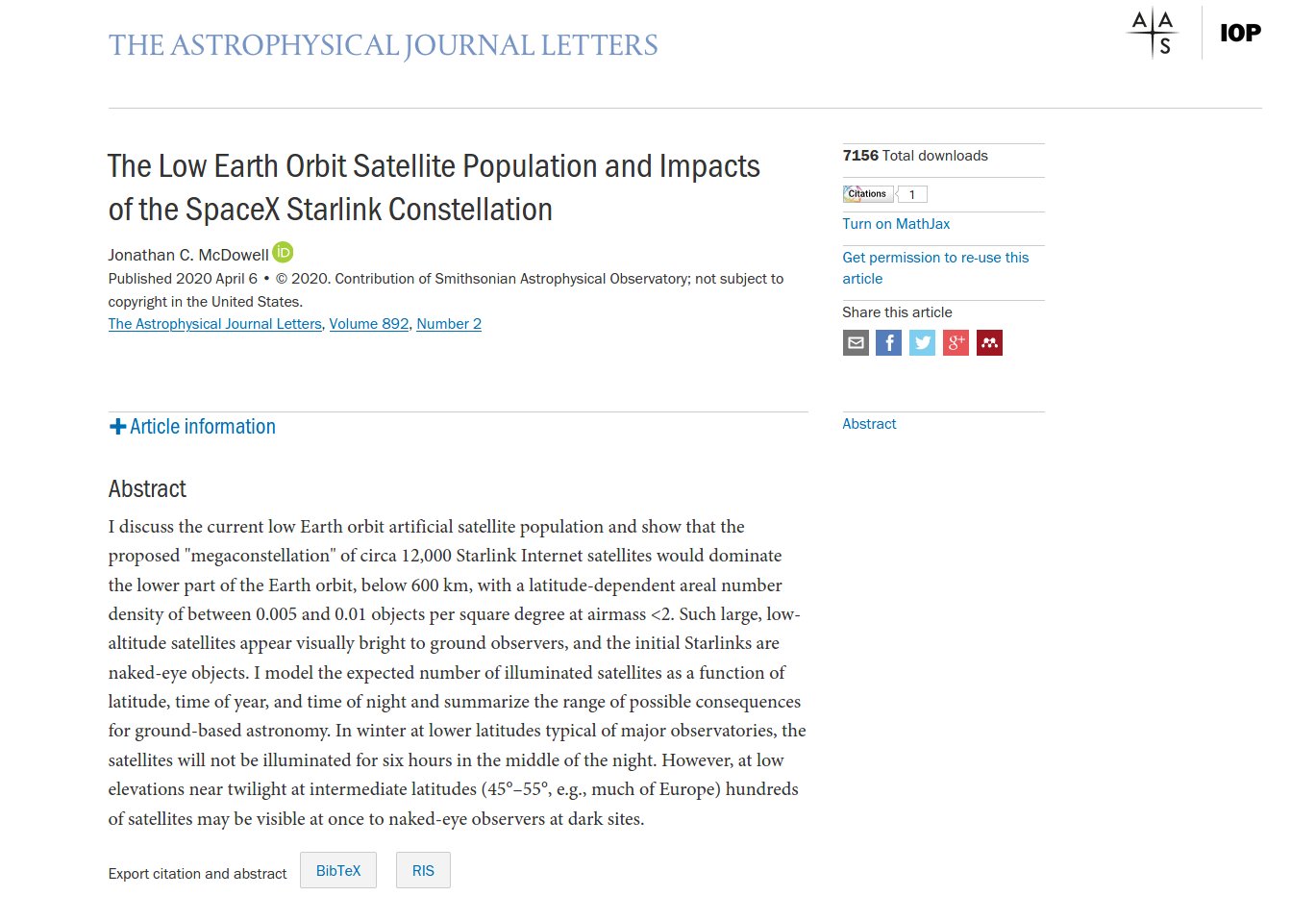In 2019 SpaceX began deploying a constellation of internet relay satellites called Starlink. The satellites are relatively large (about 3m flat-panel bus with 8m solar array) and in low (300-550 km) orbits, and in their initial design are unexpectedly bright naked-eye objects. Various proposals filed with the FCC described constellations of 4000, 12000 and ultimately 30,000 satellites. Widespread optical observations of the satellites raised the concern that the fully deployed constellation would have severe impacts on astronomical observations and even on appreciation of the night sky by ordinary people around the world.
In early 2020 the various filings represented a proposed 12000 satellite constellation. I discussed the effects of such a constellation in a paper in the Astrophysical Journal Letters:
By late May 2020, however, Starlink had updated its plans - partly in response to the concerns of astronomers. On this web page I will present updated simulations.
In Oct 2022 SpaceX released an FCC filing which gave the dimensions of the proposed Generation 2 Starlinks, as well as an intermediate Gen2 to be launched on Falcon 9:
| Satellite | Bus Dimensions (m) | Solar array size (m) | Mass (kg) |
|---|---|---|---|
| V1.5 | 2.8 x 1.3m | 2.8 x 8.1m | 303 |
| V2 Mini | 4.1 x 2.7m | 4.1 x 12.8m | 800 |
| V2 | 6.4 x 2.7m | 6.4 x 20.2m | 1250? |
- Section 1: FCC Filing Documents
- Section 2: Constellation models
- Section 3: Papers and presentations:
- Also: Relevant media stories I was quoted in during 2020-2021
- NEW 2022 simulations of number of illuminated satellites from proposed constellations
- Section 4: 2020 simulations: Visualization of distribution of satellites vs lat and lon
- Section 5: 2020 simulations: Number of satellites above horizon vs latitude
- Section 6: 2020 simulations: Number of visible satellites vs time of night
- Section 7: Altitude and surface brightness effects
For my analysis of the Starlink orbital history and notes on satellite failures, see Starlink statistics
Brightness reduction of VisorSats, graphic by Pat Seitzer, Apr 2021
Here is a flyer from the AAS [pdf] [jpg] 
- Some relevant UN documents
- Smith, F.G. Effect on Optical Astronomy of Sunlight Reflected from Spacecraft (1982)
- Dark and Quiet Skies Report (IAU/UN, Oct 2020)
- SATCON 1 Report
- SATCON 1 WG Tech Reports
- SATCON 2 Report
- SATCON 2 WG Tech Reports
- Hainaut and Williams, On the Impact of Satellite Constellations on Astronomical Observations with ESO telescopes in the Visible and Infrared Domains, A&A 636, A121
- Gallozzi et al, Concerns about ground based astronomical observations: quantifying satellites' constellations damages (preprint only)
- Mallama et al, A Flat-Panel Brightness Model for the Starlink Satellites and Measurement of their Absolute Visual Magnitude, arxiv 2003.07805
- Seitzer, Large Constellations of Satellites and Optical Astronomy BAAS 52, 311.07
- Cole, Measurement Of The Brightness Of The Starlink Spacecraft Named "DARKSAT", RNAAS 4, 42
- Tregloan-Reed et al, First observations and magnitude measurement of Starlink's Darksat, A&A 637, L1
- Mallama, Starlink Satellite Brightness Before VisorSat, arxiv 2006.08422
- Mallama, The Brightness of VisorSat-Design Starlink Satellites , arxiv 2101.00374
- Tyson et al, Mitigation of LEO Satellite Brightness and Trail Effects on the Rubin Observatory LSST AJ 160, 226
- Horiuchi, Hanayama and Ohishi, Simultaneous Multicolor Observations of Starlink's Darksat by The Murikabushi Telescope with MITSuME, arxiv 2010.04655
- Rawls, M., et al, Satellite Constellation Internet Affordability and Need, arxiv 2011:05168
- Kocifaj, M. et al, The proliferation of space objects is a rapidly increasing source of artificial night sky brightness, arxiv 2103.17125
- Bassa, C, et al, Analytical simulations of the effect of satellite constellations on optical and near-infrared observations, arXiv:2108.12335, Ast.Ap. 657, 75
- Lawler, S, Boley A, Rein H: Visibility Predictions for Near-Future Satellite Megaconstellations: Latitudes near 50 Degrees will Experience the Worst Light Pollution, arXiv:2109.04328, AJ 163, 21
- Krantz, H., Pearce E.C., Block A., Characterizing the All-Sky Brightness of Satellite Mega-Constellations and the Impact on Astronomy Research
- Mallama, Starlink Satellite Brightness -- Characterized From 100,000 Visible Light Magnitudes
- Hasan, I et al, Mitigating Satellite Trails..
- Mroz, P, et al, Impact of the SpaceX Starlink Satellites on the ZTF Survey Obs
- Malama, OneWeb Satellite Brightness -- Characterized From 80,000 Visible Light Magnitudes
- Halferty G et al, Photometric characterization...
- Krantz, H., Pearce E.C., Block A., Characterization of LEO satellites with All-Sky Photometric Signatures
- SpaceX talk at 2022 FAS including comments on new Starlink design with talk on youtube at YouTube FAS talk
- Mallama et al, Starlink Generation 2 Mini Satellites: Photometric Characterization
Recent papers by other groups:
